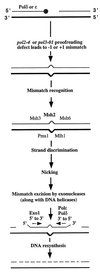The 3'-->5' exonucleases of DNA polymerases delta and epsilon and the 5'-->3' exonuclease Exo1 have major roles in postreplication mutation avoidance in Saccharomyces cerevisiae
- PMID: 10022887
- PMCID: PMC83993
- DOI: 10.1128/MCB.19.3.2000
The 3'-->5' exonucleases of DNA polymerases delta and epsilon and the 5'-->3' exonuclease Exo1 have major roles in postreplication mutation avoidance in Saccharomyces cerevisiae
Abstract
Replication fidelity is controlled by DNA polymerase proofreading and postreplication mismatch repair. We have genetically characterized the roles of the 5'-->3' Exo1 and the 3'-->5' DNA polymerase exonucleases in mismatch repair in the yeast Saccharomyces cerevisiae by using various genetic backgrounds and highly sensitive mutation detection systems that are based on long and short homonucleotide runs. Genetic interactions were examined among DNA polymerase epsilon (pol2-4) and delta (pol3-01) mutants defective in 3'-->5' proofreading exonuclease, mutants defective in the 5'-->3' exonuclease Exo1, and mismatch repair mutants (msh2, msh3, or msh6). These three exonucleases play an important role in mutation avoidance. Surprisingly, the mutation rate in an exo1 pol3-01 mutant was comparable to that in an msh2 pol3-01 mutant, suggesting that they participate directly in postreplication mismatch repair as well as in other DNA metabolic processes.
Figures

Similar articles
-
A DNA polymerase epsilon mutant that specifically causes +1 frameshift mutations within homonucleotide runs in yeast.Genetics. 2000 Aug;155(4):1623-32. doi: 10.1093/genetics/155.4.1623. Genetics. 2000. PMID: 10924461 Free PMC article.
-
Stationary-phase mutations in proofreading exonuclease-deficient strains of the yeast Saccharomyces cerevisiae.Mol Genet Genomics. 2001 Apr;265(2):362-6. doi: 10.1007/s004380000424. Mol Genet Genomics. 2001. PMID: 11361348
-
Exonuclease 1 preferentially repairs mismatches generated by DNA polymerase α.DNA Repair (Amst). 2013 Feb 1;12(2):92-6. doi: 10.1016/j.dnarep.2012.11.001. Epub 2012 Dec 11. DNA Repair (Amst). 2013. PMID: 23245696 Free PMC article.
-
Exonuclease 1-dependent and independent mismatch repair.DNA Repair (Amst). 2015 Aug;32:24-32. doi: 10.1016/j.dnarep.2015.04.010. Epub 2015 Apr 30. DNA Repair (Amst). 2015. PMID: 25956862 Free PMC article. Review.
-
Extrinsic proofreading.DNA Repair (Amst). 2022 Sep;117:103369. doi: 10.1016/j.dnarep.2022.103369. Epub 2022 Jul 4. DNA Repair (Amst). 2022. PMID: 35850061 Free PMC article. Review.
Cited by
-
Yeast DNA polymerase ϵ catalytic core and holoenzyme have comparable catalytic rates.J Biol Chem. 2015 Feb 6;290(6):3825-35. doi: 10.1074/jbc.M114.615278. Epub 2014 Dec 23. J Biol Chem. 2015. PMID: 25538242 Free PMC article.
-
FEN1 endonuclease as a therapeutic target for human cancers with defects in homologous recombination.Proc Natl Acad Sci U S A. 2020 Aug 11;117(32):19415-19424. doi: 10.1073/pnas.2009237117. Epub 2020 Jul 27. Proc Natl Acad Sci U S A. 2020. PMID: 32719125 Free PMC article.
-
A DNA polymerase epsilon mutant that specifically causes +1 frameshift mutations within homonucleotide runs in yeast.Genetics. 2000 Aug;155(4):1623-32. doi: 10.1093/genetics/155.4.1623. Genetics. 2000. PMID: 10924461 Free PMC article.
-
Palm mutants in DNA polymerases alpha and eta alter DNA replication fidelity and translesion activity.Mol Cell Biol. 2004 Apr;24(7):2734-46. doi: 10.1128/MCB.24.7.2734-2746.2004. Mol Cell Biol. 2004. PMID: 15024063 Free PMC article.
-
Regulation of mitotic homeologous recombination in yeast. Functions of mismatch repair and nucleotide excision repair genes.Genetics. 2000 Jan;154(1):133-46. doi: 10.1093/genetics/154.1.133. Genetics. 2000. PMID: 10628975 Free PMC article.
References
-
- Boeke J D, LaCroute F, Fink G R. A positive selection for mutants lacking orotidine-5′-phosphate decarboxylase activity in yeast: 5-fluoro-orotic acid resistance. Mol Gen Genet. 1984;197:345–346. - PubMed
-
- Bonneaud N, Ozier K O, Li G Y, Labouesse M, Minvielle S L, Lacroute F. A family of low and high copy replicative, integrative and single-stranded S. cerevisiae/E. coli shuttle vectors. Yeast. 1991;7:609–615. - PubMed
-
- Burns N, Grimwade B, Ross M P, Choi E Y, Finberg K, Roeder G S, Snyder M. Large-scale analysis of gene expression, protein localization, and gene disruption in Saccharomyces cerevisiae. Genes Dev. 1994;8:1087–1105. - PubMed
-
- Cooper D L, Lahue R S, Modrich P. Methyl-directed mismatch repair is bidirectional. J Biol Chem. 1993;268:11823–11829. - PubMed
MeSH terms
Substances
LinkOut - more resources
Full Text Sources
Other Literature Sources
Molecular Biology Databases
Miscellaneous
